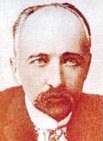|

Winter
1998 (6.4)
Architecture
of the Oil Baron Period
Baksovet
(City Hall)
4 Istiglaliyat
(Independence Avenue)
  The City Hall is one
of the most prominent buildings in Baku. Originally planned as
a monumental and ceremonial building, its main façade
faces out onto Itiglaliyyat Avenue. Built in the Baroque style,
the building was constructed between 1900 and 1904 and has two
additional wings that serve as administrative offices for Baku's
municipality. The City Hall is one
of the most prominent buildings in Baku. Originally planned as
a monumental and ceremonial building, its main façade
faces out onto Itiglaliyyat Avenue. Built in the Baroque style,
the building was constructed between 1900 and 1904 and has two
additional wings that serve as administrative offices for Baku's
municipality.
Baksovet which houses the
mayor's office. Constructed between 1900 in 1904.
The architect
Joseph V. Goslavski (1865-1904) was of Polish descent. He came
to Baku in 1891 upon graduation from the Institute of Civil Engineers
in St. Petersburg. He soon became one of the most sought-after
architects in  the
city. the
city.
To this day, his buildings are among the most distinguished in
the city. In addition to building Baksovet, he undertook the
design for the huge Alexander Nevski Russian Orthodox Cathedral
(which Stalin dynamited in the mid-1930s). The Bul-bul School of Music now stands on the site of the former cathedral.
Taghiyev was also the client of Goslavski, commissioning a residence
(History Museum), the Musical Comedy Theater (recently rebuilt) and
the first Muslim
School for Girls (Institute of Manuscripts). Goslavski also built
the Ashurbeyov
residence.
Unfortunately, Baksovet was his last project. He died of tuberculosis
upon completion of the building when he was only 39 years old.
The Baksovet has always been the city's primary municipality
building in Baku. Today, it serves as the Mayor's office.
Above: Portrait is of the
Polish architect Goslavski who built the Baksovet (City Hall)
as well as residences for Ashurbeyli and Taghiyev. Upon completion
of the City Hall, he succombed to tuberculosis and died at the
age of 39 in 1904.
From Azerbaijan International (6.4) Winter 1998.
© Azerbaijan International 1998. All rights reserved.
Back to Index
AI 6.4 (Winter 1998)
AI Home
| Magazine
Choice | Topics
| Store
| Contact
us
|


 the
city.
the
city.